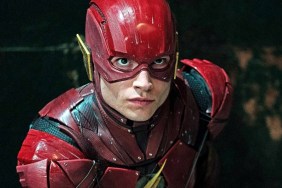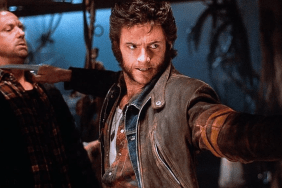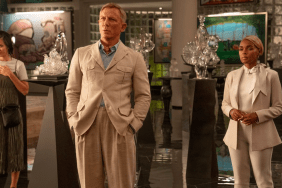We arrive at Pinewood Studios, Toronto on September 7, 2016 for day 50 of 57 on New Line Cinema‘s adaptation of Stephen King’s IT, the epic 1986 horror novel that scarred a generation thanks to a 1990 TV miniseries. Unlike the original film, director Andrés Muschietti (Mama) is not flashing back and forth between The Losers’ Club as children and adults, choosing to focus solely on their first encounter with the evil Pennywise as tweens. However, he and his producer sister Barbara Muschietti decided to update the setting from the 1950s to the 1980s.
RELATED: Watch the New IT Movie Trailer Before IT Watches You
“‘IT’ appealed to me because I always thought that the kids’ storyline was more interesting than the adults, but I also appreciate the fact that there is a dialogue between the two timelines,” Andrés Muschietti explains. “I came to the project when that was the deal, that the first movie would be about the kids, but I always insisted that if there is a second part, there would be a dialogue between the two timelines, and that it would be approached that in the adult life of the Losers there would be flashbacks that sort of illuminate events that are not told in the first one.”
“When we got into the project, that’s how it was and we agreed with it completely for two reasons,” Barbara Muschietti explains. “Try to film what you know. King writes what he knows, we try to film what we know. We grew up in the ’80s. We wanted to do a very rounded ’80s and not a caricaturesque ’80s, and we can do that because we know the period very well. Also, I think the fears in the ’50s from the book are absolutely wonderful, but we wanted less tangible fears and more internal. I think part of the adaptation in the ’80s is that we could do that without destroying the characters in the ’50s. It’s a blank slate for fears, with winks to the ’50s fears but a little less naive.”
As for whether or not they’ve actually shot flashbacks of the children for Part 2, Andy says they haven’t. “I’m just praying that the kids don’t grow up,” he adds.

The young actors portraying King’s iconic Losers’ Club include Jaeden Lieberher (Midnight Special), Jeremy Ray Taylor (Alvin and the Chipmunks: The Road Chip), Sophia Lillis (37), Finn Wolfhard (TV’s Stranger Things), Wyatt Oleff (Guardians of the Galaxy), Chosen Jacobs (Cops and Robbers), Jack Dylan Grazer (Tales of Halloween) and Nicholas Hamilton (Captain Fantastic).
Today they’re shooting on the vast sewer and cistern set where the kids go for their final confrontation with the shape-shifting evil clown Pennywise, as played by Bill Skarsgård (Allegiant, TV’s Hemlock Grove). They’re also shooting a gory bathroom scene with Lillis and a greenscreen effects shot with Skarsgård. Since they started the stage work at Pinewood, they’ve had multiple units running at once, with Andy approving/tweaking Second and Third Unit shots from a monitor. Before this, 80% of the shooting was done on location in Oshawa, Ontario.
We start our set visit on Stage 1, where they’re shooting a scene of Jaeden walking through a sewer tunnel with a flashlight. Behind him there’s a girl (Sophia Lillis’ Beverly) floating in the air, which he notices when he turns around. By the third take, Jaeden is reacting more to the sight of the girl, holding his flashlight on her longer, a pipe drizzling water behind him. The shot is tighter too. The sight of a crew member placing the girl in suspension over the set before each take is surreal. Jaedon is playing each take more terrified. Next they shoot a ball pass, where a guy holds a grey ball for lighting reference.

After the lunch bell we enter the tunnel. The expansive floors are wet and filthy, so we’re wearing special rubber boots. In the massive circular Water Room there are huge rusty pipes. Moss hangs from the ceiling inside the main conduit. Pennywise’s house, and old Victorian circus wagon, is at the center of a literal mountain of children’s clothing and other items, (toys, dolls, stuffed animals, etc) reaching almost to the ceiling. Some of the toys are real antiques. The pile represents Pennywise’s past child victims. The clothes get cleaner/newer towards the top. There is greenscreen at the ceiling for them to further extend the set in post, where there will be even more children floating at the top.
“It’s a crazy set,” admits Jaeden Lieberher, who plays the group’s stuttering leader Bill. “That’s basically Pennywise’s liar and that’s where we fight him and try to defeat him. That’s where we rescue Beverly. It’s kind of amazing being there with all the toys and you feel like there is a monster living in there. And he has killed a bunch of children.”
“It’s super fun, it’s just like, it’s weird,” says Finn Wolfhard, who plays the wisecracking Richie Tozier. “It’s very surreal thinking like I’m going to go into work today and there’s going to be four dead bodies in the water and it’s like ‘Oh cool. This is my job and this is my life. Uh, cool.'”
The most iconic element of King’s story and the original miniseries was Pennywise, first portrayed by Tim Curry in Bozo-like makeup. However, Andy wanted to cast a much younger, more sympathetic-looking Pennywise in Victorian clown garb for his film, and turned to Skarsgård.
“This entity has been around for thousands of years,” said Andy Muschietti of what influenced Pennywise’s new look. “I don’t dig the 20th century clown. I think it looks cheap, and it’s too related to social events and the circus and stuff. Circus is fine, but I’m more aesthetically attracted to the old time, like the 19th century clown. Given that this guy has been around for centuries, I wondered why not have an upgrade that was 1800s.”

“Somewhere in the book where they see a flashback to a completely different time, to a time before man was around and that’s when IT came to Earth,” Bill Skarsgård explains. “IT laid dormant for millions and millions of years until humans reached the Americas and he’s been around ever since humans have been here, doing the same thing. The Natives probably have experienced being haunted and tormented by this entity as well before the Europeans came and so forth.
“So, Pennywise is obviously a much more modern version of what form it has been taking. You could assume that 5,000 years ago it would’ve been something that terrified people at that time, a spirit or something like that. In our version, Pennywise is something that’s been around and drew inspiration from a real person, in Bob Gray, and created this version of a clown that fit the 19th century. That being said, the entity IT has always been the same. I don’t think IT ever changes. The story of The Losers’ battling it is the first time he’s ever changed whatsoever. That’s my arc. If you see the film, I think you’ll discover that there’s a change that happens in Pennywise or IT that’s never happened before.”
“It’s a different approach, but also he’s not sticking to one voice,” Andy explains. “He has different personas. Because it’s a character that is based on unpredictability, so he has this stagey persona, the more clowny appearance, but then in certain scenes when he turns into this other, which is harder to grasp, and that’s the ‘other,’ you know, the IT. He has a different tone, he has a deeper voice, and a different feel to it.”
“We read the novel when we were teens, we saw the miniseries much later in the game, so Tim Curry’s performance is extraordinary but that is not necessarily what we link to Pennywise immediately,” Barbara adds. “For us, the Pennywise is the Pennywise in the book, which is quite different. I think Bill went for that and he did an amazing performance and we gave him several tests. Again, because he’s a shape shifter, we wanted to make sure that he could play in different grades, right? And he did. He’s amazing. And what’s even more amazing is that he kept the character very unpredictable, and that’s what scares us the most, when you don’t know what way he’s going to go. You see Tim Curry and you already know that he’s an evil clown. There’s never a doubt about this. This Pennywise plays with his food. He taunts them, and that is very amusing but very disturbing at the same time, and very scary. I would say that’s one of the main differences.”

We head to a different stage where a green screen is set up, with Pennywise poking his head through what looks like a picture frame. Unlike the book, where this scene revolved around a picture album, the film uses a carousel slideshow and Pennywise is bursting from the screen. Bill’s costume looks very Victorian in person, almost Shakespearian. In a startlingly normal voice, Bill asks them to adjust the monitor. He’s definitely not doing this performance method, thank God. He works with Andy to practically adjust his blocking. In the take he looks left, then pushes himself out through the hole.
Gearing up for a take, Bill lets out a terrifying chuckle, which he does with even more intensity in the take. On the monitor they’re cross-referencing a reaction shot from the character Stan (Wyatt Oleff). In the second take, Bill holds a smile and does a more controlled yelp. Andy smiles like a happy child as he re-blocks Bill to shake his head like a rabid dog. Bill smiles at the end of the next take. He has a psychotic glint in his eye when he is in character. They release Bill to go cool off while they set up a side-angle. In between takes Bill stands by the monitor with his clown suit off, chatting and yucking it up with Barbara.
“We call it the ancestral clown,” Barbara says. “It’s not of any particular era but you know it’s not present clown. It’s beyond, from above, the past and the future. It’s Pennywise. In the miniseries it’s so clearly Bozo, but also in the book you have moments of Pennywise where you see his blue eyes and a little more childlike wonder, and that’s something that we will see which the miniseries didn’t represent.”

As for his interaction with the kids, at first the production tried to keep Bill and the kids as separate as possible.
“They shouldn’t be buddies with Pennywise, so we did keep it separate,” Skarsgård says. “We kept me separated from them and essentially the only people I had any contact with was Andy Muschietti and Barbara, the producer, his sister. Those were the only people I really hung out with in terms of anyone in the production.”
However, while filming a particular scene Bill learned just how professional the kid actors were.
“I did a scene with Jack Grazer, who plays Eddie in the film, and it’s a full on, aggressive, intense scene between Pennywise and Eddie,” recalls Skarsgård. “It was my first day of shooting and I was trying to stay focused and in character when we were rehearsing it and Jack was really a trooper. Then we shot the scene, the first take, and I really kind of saved my energy for that scene and we shot it and it’s a lot! He’s obviously terrified in the scene and crying and trying to get away and Pennywise is there in front of his face. Then they shout CUT! and I turn to Jack and ask, ‘Are you okay?’ and he goes, ‘That was awesome, man! That was f*cking awesome! You should, like, WOW WOW! I love what you’re doing!’ [laughs] So, I was happy I’m not dealing with little children but actual actors, little actors but actors nonetheless! The kids are really smart and talented and come up with great ideas for the scene and I think the necessity of keeping me separate from the kids was, you know, as soon as we started shooting it was pretty clear that these kids knew they were making a film and I’m not a murderous clown.”
IT opens in theaters on September 8.
Stephen King's IT
-
IT

-
IT

-
IT

-
IT

-
IT

-
IT

-
IT

-
IT

-
IT

-
IT

-
IT

-
IT

-
IT

-
IT

-
IT

-
IT

-
IT

-
IT

-
IT

-
IT

-
IT

-
IT

-
IT

-
IT

-
IT

-
IT

-
IT

-
IT

-
IT

-
IT

-
IT

-
IT Art from Gallery1988

Artist: Doaly
-
IT

-
IT

-
IT

-
IT

-
IT

-
IT

-
IT

-
IT

-
IT

-
IT

-
IT

-
IT

-
IT

-
IT

-
IT

-
IT

-
IT

-
IT

-
IT










